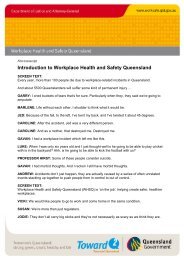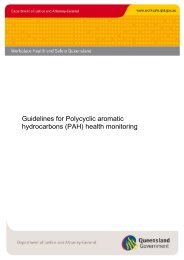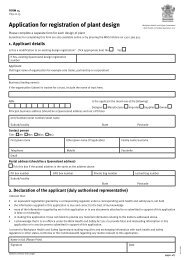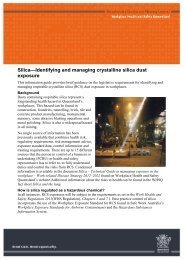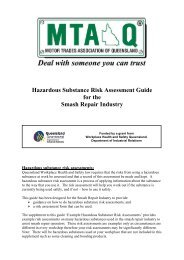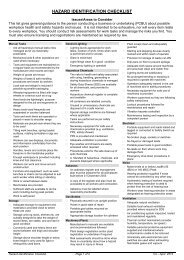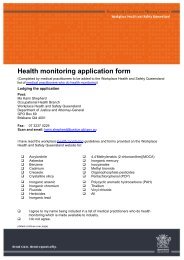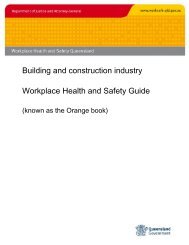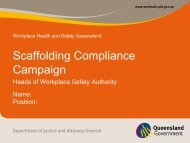Isocyanate health monitoring guidelines - Queensland Government
Isocyanate health monitoring guidelines - Queensland Government
Isocyanate health monitoring guidelines - Queensland Government
You also want an ePaper? Increase the reach of your titles
YUMPU automatically turns print PDFs into web optimized ePapers that Google loves.
<strong>Isocyanate</strong> <strong>health</strong> <strong>monitoring</strong>Substance:<strong>Isocyanate</strong>Chemical formula: <strong>Isocyanate</strong>s are low molecular weight compounds with thegroup N=C=O which is chemically highly reactive. <strong>Isocyanate</strong>s are classified based on thenumber of N=C=O groups in the molecule into monoisocyanates, diisocyanates monomers(two NCO), or polyisocyanates (multiple NCOs). The diisocyanates monomers are importantbecause the two NCO groups allow them to undergo direct polymerisation reactions withalcohols to form polyurethanes. <strong>Isocyanate</strong>s are also classified as either aromatic (one ormore aromatic rings) or saturated (aliphatic and alicyclic)Exposure standards: Australia ES (TWA) 1 all isocyanates (as NCO): 0.02 mg/m 3STEL 2 0.07 mg/m 3ACGIH TLV 3Hexamethylene Diisocyanate (HDI) 0.005 ppm = 0.034 mg/m 3Methylene bisphenyl isocyanate (MDI) 0.005 ppm = 0.051 mg/m 3Toluene Diisocyanate (TDI) 0.005 ppm = 0.036 mg/m 3 , STEL 0.14 mg/m 3Main uses/occupations at riskUse of isocyanates and means of industrial exposureIndustry Occupation How used Route ofexposureAutomotiveInsulationConstructionFurnitureSpray-painter,sanderFurniture factoryworkerMattress factoryworkerHDI Rigid body parts suchas steering wheels, carbumpers, seatingmotor vehicle body paintsMDI-based rigid foams forthermal insulation ofrefrigerators and storagetanks, packaging, furnitureTDI-based flexible foamsfor bedding, upholsteryInhalationDermalInhalationDermalInhalationDermalTimber floorfinishingFloor sanderHard wearing coatings forfurniture, floorsInhalationDermalAliphatic isocyanates such as those based on hexamethylene diisocyanate (HDI) are usedprimarily onsite as curing agents in the formation of polyurethane paint systems forautomobile refinishing, marine coatings and other high performance coating systems due totheir excellent resistance to chemicals and abrasion, and superior weathering characteristicssuch as gloss and colour retention. Free HDI monomer content of the paint and coatingsystems range from 0.5% to 1.6% HDI. Aromatic isocyanates include toluene diisocyanate(TDI) which is volatile at room temperature and is used in foam manufacture, varnishes and1 Exposure standard Time Weighted Average (8 hour day) Available at SafeWork Australia Hazardous SubstancesInformation System http://hsis.ascc.gov.au/SearchES.aspx2 Short term exposure limit (15 mins)3 American Conference of <strong>Government</strong>al Industrial Hygienists Threshold Limit ValueWorkplace Health and Safety <strong>Queensland</strong>, Department of Justice and Attorney-General<strong>Isocyanate</strong> <strong>health</strong> <strong>monitoring</strong> <strong>guidelines</strong>PN10456 Version 2. Last updated June 2012
paints, adhesives, surface coatings and the insulation around copper wire used in electronicsand liberated during soldering. Methylene diphenyl diisocyanate (MDI) is solid at roomtemperature and is used in polyurethane foam manufacture, adhesives, binders and elastomersand cores for castings in foundries.In order to minimise the content of free isocyanates in paint, manufacturers pre-reactisocyanates to polyisocyanates. Polyisocyanates still contain multiple free NCO groups andcan further react and up to 0.5% free isocyanates are still present in the paint.Figure 1: isocyanates in spray-paintingOther usesFootwear, sports goods such as skis and surf boards, adhesives and binders.Target organ/effectRespiratory tract – irritation, sensitisation with occupational asthmaEyes – irritationSkin – irritation, sensitisationCNS – headache, loss of consciousness, comaWorkplace Health and Safety <strong>Queensland</strong>, Department of Justice and Attorney-General<strong>Isocyanate</strong> <strong>health</strong> <strong>monitoring</strong> <strong>guidelines</strong>PN10456 Version 2. Last updated June 2012
Type of <strong>health</strong> <strong>monitoring</strong> required demographic, medical and occupational history <strong>health</strong> advice standard respiratory questionnaire physical examination of respiratory system and skin standard respiratory function testsFrequency of <strong>monitoring</strong> baseline 6 weeks 6 months and thereafter, annuallyThere is no existing evidence that pre- and post-shift changes in lung function is eithersensitive or specific for the validation or exclusion of occupational asthma. 4Identification and evaluation of a case of occupational asthma in the worker presenting withrespiratory symptoms. 5 Asthma symptoms reported at questionnaire to be better on days away from work oron holiday have a sensitivity of 58-100% for validated occupational asthma The minimum criteria for serial measurements of peak flow to maintain a high degreeof diagnostic accuracy is at least four readings a day, at least three consecutiveworkdays in each work period and at least three weeksBiological occupational exposure levels (BOEL)Urine isocyanate biological <strong>monitoring</strong> is used in the UK 6 as a tool to assess exposure toisocyanates and the efficacy of controls. Laboratories in Australia are currently developingtests for urine isocyanate.Absorption/excretion pharmacology 7The most commonly used diisocyanates are toluene diisocyanate (TDI), methylenediphenyl diisocyanate (MDI) and hexamethylene diisocyanate (HDI). The risk ofexposure depends on the volatility of the compound and the application process. The mostvolatile of the isocyanates are those with low molecular weight such as TDI used inpolyurethane foam manufacturing. <strong>Isocyanate</strong>s used in paints such as HDI are less volatilebut the spray painting process creates a mist of easily inhaled fine particles.There is growing evidence that skin exposure can induce isocyanate respiratory sensitisationalthough this is still under debate. Skin exposure may be especially important with less4 Nicholson PJ, Cullinan P, Burge PS & Boyle C. Occupational asthma: Prevention, identification &management: Systematic review & recommendations. British Occupational Health Research Foundationhttp://www.bohrf.org.uk/downloads/OccupationalAsthmaEvidenceReview-Mar2010.pdf5 ibid6 http://www.hse.gov.uk/pubns/guidance/g408.pdf7 ACGIH Biological Exposure Indices 2007Workplace Health and Safety <strong>Queensland</strong>, Department of Justice and Attorney-General<strong>Isocyanate</strong> <strong>health</strong> <strong>monitoring</strong> <strong>guidelines</strong>PN10456 Version 2. Last updated June 2012
volatile diisocyanates such as polyisocyanates and MDI where skin exposure may be themain route of exposure. 8The mechanism of isocyanate-induced sensitisation remains uncertain but the high reactivityof the NCO functional group is believed to be the key in the process. <strong>Isocyanate</strong>s areelectrophilic (electron accepting) and bind to carrier proteins, via the reaction of the NCOgroup with nucleophiles (electron supplier) such as SH, NH 2 , NH and OH groups present inthese proteins. Several peptides and proteins found in airway epithelial cells, serum and skinhave been observed to bind diisocyanates, including glutathione, albumin and keratin.The minimum dose necessary for immune sensitisation remains unclear. Diisocyanateasthma has been associated with both the induction of a classical IgE-mediated type I allergicresponse as well as the non-IgE-mediated asthma and induction of nonspecific airwayresponsiveness. Specific immunoglobulin E (IgE) antibodies have been detected in 10-30%of symptomatic isocyanate workers. 9Summary of toxicology 10,11Acute effectsTDI and other volatile isocyanates are acute irritants of the eyes, mucous membranes,respiratory tract and skin. In mild cases there may be slight irritation of the nose and throat.With higher exposure there may be acute bronchial irritation with coughing, shortness ofbreath and bronchospasm, abdominal distress, nausea and vomiting, chemical pneumonitisand pulmonary oedema. Reactive airways dysfunction syndrome (RADS) is new onsetasthma which begins within hours following a single exposure to inhaled irritants at veryhigh concentrations and continues to be symptomatic at three months or longer. Evidence isemerging that RADS can be seen as one end of a spectrum of irritant effects on the airways.Acute dermatitis results from either massive skin contamination or a hyper-responsiveness ofthe skin.Oral toxicity appears to be low.Chronic effects 12Chronic exposure to isocyanates can cause contact dermatitis, immune sensitisation andasthma and less commonly hypersensitivity pneumonitis.Diisocyanates appear to be weak human skin irritants and sensitisers and if this occurs it isusually due to inadequate occupational hygiene giving rise to extensive skin contaminationwith diiosocyanates, solvents and additives.The estimated prevalence of occupational asthma in the isocyanate exposed workforce hasmost commonly been reported in the range 5-10%. There is no evidence that atopy influencessusceptibility. Smoking has been identified as increasing the risk of occupational asthma in8 Bello D, Woskie S, Streicher R, Liu Y, Stowe M, Eisen E et al. Polyisocyanates in occupational environments: A criticalreview of exposure limits and metrics. Am J Industrial Medicine, 2004; 46:480-491.9 Raulf-Heimsoth M, Baur X. Pathomechanisms and pathophysiology of isocyanate induced disease. Am J Ind Medicine,1998; 34:137-143.10 Allport D, Gilbert D, Outterside S. MDI and TDI Safety, Health and the Environment, New York: John Wiley and Sons;2003.11 ACGIH Documentation of the threshold limit values for chemical agents 7 th edition 200712 Hendrick D et al, op.cit.Workplace Health and Safety <strong>Queensland</strong>, Department of Justice and Attorney-General<strong>Isocyanate</strong> <strong>health</strong> <strong>monitoring</strong> <strong>guidelines</strong>PN10456 Version 2. Last updated June 2012
workers exposed to isocyanates. Sensitisation and occupational asthma are most likely todevelop in the first years of exposure for workers.Spray painters using two-pack polyurethane paints are the group at highest risk. The repairand refinishing of cars entails the sprayed on application of isocyanate-containing coatings onalmost every vehicle. There is a latent (sensitising) period of exposure to isocyanates that ishighly variable: from several weeks, often less than two years but in 20% of cases, 10 yearsor more. Exposure to higher concentrations from spills may increase the risk of sensitisation.Once sensitisation has occurred, ongoing exposures cause asthmatic reactions and increasesin the background level of airway responsiveness. Some workers become extremely sensitiveto isocyanates and the high likelihood of chronicity of occupational asthma (depends onduration of symptoms prior to cessation of exposure) places a high priority on primaryprevention of sensitisation.A rare consequence of chronic isocyanate exposure is hypersensitivity pneumonitis, agranulomatous inflammatory reaction in terminal airways, alveoli and surroundinginterstitium. Symptoms are dyspnoea, malaise and fever occurring several hours after workwith isocyanates. Diagnosis is confirmed by restrictive ventilatory patterns, reticular ornodular lung patterns on chest X-ray.Summary of epidemiology 13There is evidence in animal models that skin exposure can be an important route ofisocyanate sensitisation. Although the evidence in humans is more limited it is likely that skinexposure can induce isocyanate sensitisation.Acute and chronic decrease of ventilatory capacity measured as FEV 1 induced byoccupational TDI exposure has been reported by several authors.A cross-sectional epidemiological study, the Study of Painters and Repairers of Autobodiesby Yale (SPRAY) 14 , was performed to characterise the <strong>health</strong> effects of isocyanate exposureson actively employed autobody shop workers and to elucidate exposures. Among 102workers, there was a high rate of airway symptoms consistent with occupational asthma(19.6%).During 1976 to 1992, 245 cases of diisocyanate-induced asthma were diagnosed at theFinnish Institute of Occupational Health. 15 A questionnaire was sent to the 235 patients alivein 1995, and validated by re-examining clinically 91. The study was carried out on average10 (3 to19) years after the diagnosis: 82% experienced symptoms of asthma, 34% used nomedication and 35% were on regular medication. These results confirm the generally ratherpoor medical outcome for diisocyanate-induced asthma and the persistence of symptoms andnon-specific bronchial reactivity.Further information/referencesACGIH. Documentation of the Threshold Limit Values for Chemical Agents. 7th ed. 200713 ACGIH. Documentation of the threshold limit values for chemical agents. 7 th edition 200714 Cullen MR, Redlich CA, Beckett WS, Weltmann B, Sparer J, Jackson G et al. Feasibility study of respiratoryquestionnaire and peak flow recordings in autobody shop workers exposed to isocyanate-containing spray paint. OccupMed. 1996; 46:197-204.15 Piirila PL, Nordman H, Keskinen HM, Luukkonen R Salo SP, Tuomi TO et al. Long-term follow-up of HMDI, MDI andTDI induced asthma. American Journal of Respiratory and Critical Care Medicine, 2000; 162: 516-522.Workplace Health and Safety <strong>Queensland</strong>, Department of Justice and Attorney-General<strong>Isocyanate</strong> <strong>health</strong> <strong>monitoring</strong> <strong>guidelines</strong>PN10456 Version 2. Last updated June 2012
British Occupational Health Research Foundation. Occupational Asthm: Evidence review –March 2010. www.bohrf.org.ukNOHSC. Exposure Standards for Atmospheric Contaminants in the OccupationalEnvironment. [NOHSC:3008 (1995)]. See also http://hsis.ascc.gov.au/Burge S. Respiratory symptoms. Occupational Medicine, 1997; 47: 55-56.Bernstein DI, Jolly A. Current diagnostic methods for diisocyanate induced occupationalasthma. American Journal of Industrial Medicine, 1999; 36: 459-468.Occupational asthma in Australia Australian Institute of <strong>health</strong> and Welfare bulletin 59 April2008 at www.aihw.gov.au© The State of <strong>Queensland</strong> (Department of Justice and Attorney-General) 2012Copyright protects this document. The State of <strong>Queensland</strong> has no objection to this material being reproduced, but asserts its right to berecognised as author of the original material and the right to have the material unaltered.The material presented in this publication is distributed by the <strong>Queensland</strong> <strong>Government</strong> as an information source only. The State of <strong>Queensland</strong>makes no statements, representations, or warranties about the accuracy or completeness of the information contained in this publication, and thereader should not rely on it. The <strong>Queensland</strong> <strong>Government</strong> disclaims all responsibility and all liability (including, without limitation, liability innegligence) for all expenses, losses, damages and costs you might incur as a result of the information being inaccurate or incomplete in any way,and for any reason.Workplace Health and Safety <strong>Queensland</strong>, Department of Justice and Attorney-General<strong>Isocyanate</strong> <strong>health</strong> <strong>monitoring</strong> <strong>guidelines</strong>PN10456 Version 2. Last updated June 2012





